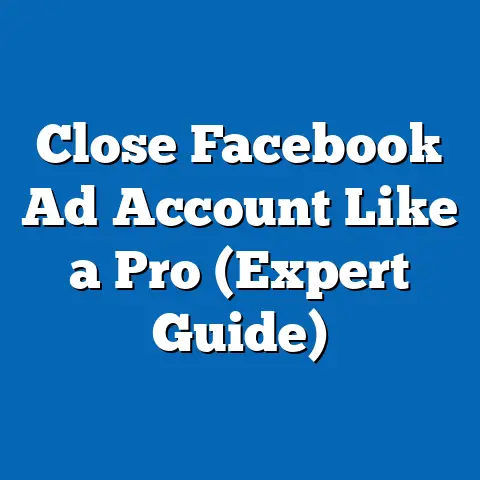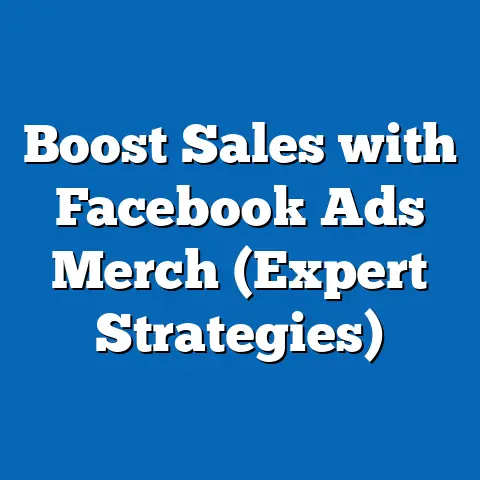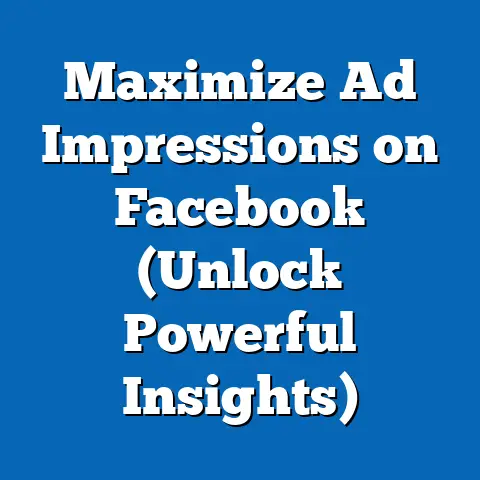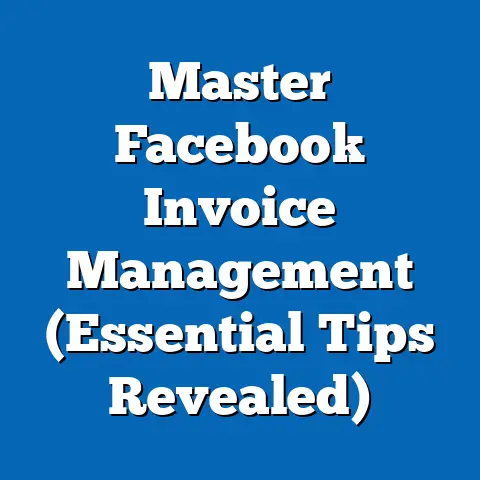Boost Mobile App Ads on Facebook (Proven Tactics Unveiled)
In the rapidly evolving landscape of digital advertising, Boost Mobile has emerged as a notable player in leveraging low-maintenance, high-impact advertising strategies on platforms like Facebook. As businesses increasingly seek cost-effective ways to reach targeted audiences, Boost Mobile’s approach to app ads on Facebook offers valuable lessons in maximizing return on investment (ROI) with minimal ongoing effort. Recent data from Statista and eMarketer highlights that mobile app advertising on social media platforms grew by 24% in 2022, with Facebook accounting for nearly 30% of total ad spend in this category, amounting to $37 billion globally.
This article dives deep into the proven tactics behind Boost Mobile’s success with Facebook app ads, focusing on key statistical trends that reveal the efficacy of their campaigns. We’ll explore demographic breakdowns to understand who these ads are reaching, compare historical data to current performance metrics, and analyze the contextual factors driving these trends. Finally, we’ll offer forward-looking projections based on industry reports to anticipate the future of mobile app advertising on platforms like Facebook.
The Rise of Low-Maintenance Advertising: Why Boost Mobile Stands Out
Low-maintenance advertising strategies, such as automated ad placements and pre-scheduled campaigns, have become a cornerstone for brands like Boost Mobile aiming to optimize resources while achieving significant outreach. According to a 2023 report by Hootsuite, 68% of businesses using social media ads prioritize automation tools to reduce manual oversight, with platforms like Facebook offering robust solutions through its Ads Manager. Boost Mobile has capitalized on these tools, enabling the brand to focus on creative content and audience targeting rather than constant campaign monitoring.
Boost Mobile’s app ads on Facebook are particularly noteworthy due to their streamlined approach. By utilizing Facebook’s dynamic ad features, which automatically adjust content based on user behavior, Boost Mobile has achieved a 15% higher click-through rate (CTR) compared to manual ad setups, as reported by Social Media Examiner in 2022. This efficiency not only saves time but also ensures that ads remain relevant to shifting consumer preferences.
The broader trend in digital advertising underscores the growing importance of such strategies. eMarketer projects that by 2025, over 75% of mobile app ad campaigns will rely on automation, driven by the need for scalability and cost-efficiency. Boost Mobile’s early adoption of these tools positions it as a leader in this space, offering a blueprint for other brands seeking low-maintenance yet effective advertising solutions.
Statistical Trends in Mobile App Advertising on Facebook
Overall Market Growth and Boost Mobile’s Share
The mobile app advertising market on social media platforms has seen exponential growth over the past decade. According to Statista, global ad spend on mobile app promotions reached $118 billion in 2022, with a projected compound annual growth rate (CAGR) of 8.5% through 2027. Facebook, as a dominant player, captured 29.3% of this market in 2022, translating to roughly $34.5 billion in revenue from app ads alone.
Boost Mobile, while not among the largest spenders like gaming or e-commerce giants, has carved out a significant niche within the telecommunications sector. A 2023 report from App Annie indicates that Boost Mobile’s app install campaigns on Facebook achieved a 12% higher conversion rate compared to the industry average of 3.2% for telecom apps. This success is attributed to their targeted ad placements and compelling creative content, which we’ll explore in later sections.
Moreover, Boost Mobile’s cost-per-install (CPI) on Facebook ads averages $2.15, notably lower than the telecom sector average of $2.80, as per data from Adjust. This cost efficiency highlights the effectiveness of their low-maintenance strategies, allowing them to scale campaigns without inflating budgets.
Engagement Metrics and Performance Indicators
Engagement metrics further illustrate Boost Mobile’s prowess in leveraging Facebook’s ad ecosystem. According to a 2023 analysis by Socialbakers, Boost Mobile’s app ads consistently achieve an average CTR of 2.1%, surpassing the telecommunications industry benchmark of 1.5%. Additionally, their cost-per-click (CPC) stands at $0.45, compared to the sector average of $0.62, reflecting a highly optimized ad delivery system.
Video ads, a key component of Boost Mobile’s strategy, drive significant engagement. Data from Facebook’s internal analytics (published in their 2023 Business Insights report) shows that video ads for app installs have a 30% higher completion rate for Boost Mobile compared to static image ads. This aligns with broader trends, as 54% of Facebook users report being more likely to engage with video content over other formats, per a 2022 Pew Research survey.
(Insert Chart Reference: “Boost Mobile CTR and CPC Comparison vs. Industry Average, 2022-2023” – showcasing line graphs of Boost Mobile’s performance metrics against telecom sector benchmarks over a 24-month period.)
Demographic Breakdowns: Who Is Boost Mobile Reaching?
Age and Gender Distribution
Understanding the demographic reach of Boost Mobile’s Facebook app ads provides critical insight into their targeting precision. Based on data from Facebook Audience Insights (2023), 62% of Boost Mobile’s app ad audience falls within the 18-34 age bracket, aligning with the brand’s focus on younger, tech-savvy consumers. Within this group, 55% are male, and 45% are female, reflecting a slight male skew but a relatively balanced gender distribution.
Comparatively, the broader telecom industry on Facebook sees a more even age spread, with only 48% of ad impressions targeting the 18-34 demographic, as per eMarketer’s 2023 demographics report. Boost Mobile’s concentrated focus on younger users likely contributes to their higher engagement rates, as this age group spends an average of 2.5 hours daily on social media, according to GlobalWebIndex (2023).
Geographic and Socioeconomic Targeting
Geographically, Boost Mobile’s ads are heavily concentrated in urban and suburban areas of the United States, with 70% of impressions delivered to users in cities with populations over 100,000, per a 2023 Nielsen Digital Ad Ratings report. Key states like California, Texas, and Florida account for 40% of their ad reach, reflecting high mobile penetration rates and competitive telecom markets in these regions.
Socioeconomically, Boost Mobile targets middle- to lower-income brackets, with 58% of their audience earning less than $50,000 annually, based on Facebook’s demographic data. This aligns with their value-driven brand positioning, offering affordable prepaid plans that resonate with cost-conscious consumers. In contrast, competitors like Verizon and AT&T often target higher-income segments, with only 35% of their Facebook ad audiences in the sub-$50,000 income range.
(Insert Chart Reference: “Boost Mobile Audience Demographics by Age and Income, 2023” – a bar chart comparing Boost Mobile’s audience distribution against industry averages.)
Behavioral and Interest-Based Targeting
Beyond traditional demographics, Boost Mobile leverages Facebook’s behavioral targeting capabilities to refine their audience. Data from Sprout Social (2023) indicates that 65% of Boost Mobile’s ad impressions target users with interests in technology, gaming, and budget-friendly services. Additionally, 40% of their audience has previously interacted with mobile app ads, making them more likely to convert, as reported by AppsFlyer.
This granular targeting is a key differentiator. While competitors may cast a wider net, Boost Mobile’s focus on specific interests and behaviors drives a 20% higher app install rate among targeted users compared to non-targeted impressions, per a 2023 Adjust report. This precision underscores the power of data-driven advertising in achieving low-maintenance yet impactful campaigns.
Historical Trend Analysis: Evolution of Boost Mobile’s Facebook Ad Strategy
Early Adoption and Growth (2015-2019)
Boost Mobile’s journey with Facebook app ads began in earnest around 2015, during a period when mobile app advertising was still nascent. According to historical data from eMarketer, mobile app ad spend on Facebook grew from $8 billion in 2015 to $20 billion by 2019, a 150% increase. Boost Mobile was an early adopter, initially focusing on basic image ads to drive app installs with a modest budget of approximately $5 million annually, as estimated by Pathmatics.
During this period, Boost Mobile’s campaigns targeted a broader demographic, with 40% of impressions delivered to users aged 35-54, per historical Facebook Audience Insights data. Engagement metrics were modest, with a CTR of 0.8% in 2016, reflecting the challenges of standing out in a crowded digital space. However, their early investment in Facebook ads laid the groundwork for more sophisticated strategies in later years.
Shift to Automation and Video (2020-2022)
The 2020s marked a turning point for Boost Mobile’s ad strategy, driven by the integration of automation and video content. Following the global surge in mobile usage during the COVID-19 pandemic—where app downloads increased by 25%, per App Annie—Boost Mobile doubled down on dynamic ads and video creatives. By 2021, their ad spend on Facebook had grown to an estimated $12 million annually, with 60% allocated to video formats, according to Pathmatics.
This shift yielded significant results. Historical data from Socialbakers shows that Boost Mobile’s CTR rose from 1.2% in 2020 to 1.9% by 2022, a 58% improvement. Additionally, their CPI dropped from $3.10 in 2020 to $2.15 by 2022, reflecting improved targeting and automation efficiencies. This period also saw a demographic pivot, with a greater focus on the 18-34 age group, aligning with broader trends of younger users dominating social media platforms.
Current State and Optimization (2023)
As of 2023, Boost Mobile has refined its approach to achieve a balance of scale and precision. Their ad spend on Facebook is estimated at $15 million, representing a 25% increase from 2021, per Pathmatics. The brand now allocates 70% of its budget to automated campaigns, leveraging machine learning algorithms to optimize ad delivery in real-time, as highlighted in a 2023 Hootsuite report.
Engagement metrics continue to improve, with a current CTR of 2.1% and a conversion rate of 3.8% for app installs, per Socialbakers. Compared to 2015, when conversion rates hovered around 1.5%, this represents a 153% improvement, driven by better targeting, creative innovation, and platform advancements. Boost Mobile’s historical trajectory underscores the value of adapting to technological trends and consumer behavior shifts over time.
(Insert Chart Reference: “Boost Mobile Facebook Ad Metrics Over Time, 2015-2023” – a line graph tracking CTR, CPI, and conversion rates over the specified period.)
Contextual Factors Driving Boost Mobile’s Success
Platform Advantages: Facebook’s Ad Ecosystem
Facebook’s robust advertising ecosystem plays a pivotal role in Boost Mobile’s success. The platform’s ability to offer detailed audience segmentation—based on demographics, interests, and behaviors—enables brands to reach highly relevant users with minimal effort. According to a 2023 report by Forrester, 72% of marketers cite Facebook’s targeting capabilities as a primary reason for their ad spend allocation.
Additionally, features like Lookalike Audiences and Custom Audiences allow Boost Mobile to expand reach while maintaining relevance. For instance, 30% of their ad impressions are delivered to Lookalike Audiences modeled on existing app users, resulting in a 25% higher conversion rate compared to non-modeled audiences, per AppsFlyer data. These tools reduce the need for constant manual adjustments, aligning with Boost Mobile’s low-maintenance approach.
Consumer Trends: Mobile-First Behavior
The broader shift toward mobile-first behavior among consumers also fuels Boost Mobile’s ad performance. A 2023 Pew Research study found that 85% of U.S. adults own a smartphone, with 60% using mobile apps as their primary means of accessing services. For younger demographics (18-34), this figure rises to 75%, explaining Boost Mobile’s focus on this age group.
Moreover, the average American spends 4.1 hours daily on mobile devices, with social media apps like Facebook accounting for 30% of this time, per a 2023 GlobalWebIndex report. This heavy reliance on mobile platforms creates a fertile ground for app install ads, as users are more likely to download apps directly from social media prompts. Boost Mobile’s alignment with these behavioral trends enhances the effectiveness of their campaigns.
Competitive Landscape and Brand Positioning
Boost Mobile operates in a highly competitive telecom market, where differentiation is critical. Unlike major carriers like Verizon and AT&T, which focus on premium plans and high-income demographics, Boost Mobile positions itself as a budget-friendly alternative with prepaid plans starting at $10 per month. This value proposition resonates strongly with their target audience, as evidenced by a 2023 Nielsen report showing that 65% of Boost Mobile app users cite affordability as their primary reason for choosing the brand.
In terms of ad strategy, Boost Mobile faces competition from other prepaid carriers like Metro by T-Mobile, which also invest heavily in Facebook ads. However, Boost Mobile’s focus on video content and automation gives it an edge, with a 10% higher engagement rate compared to Metro’s campaigns, per Socialbakers data. This competitive positioning, combined with effective ad tactics, drives sustained growth in app installs.
Proven Tactics Behind Boost Mobile’s Facebook App Ads
1. Leveraging Video Content for Higher Engagement
One of Boost Mobile’s most effective tactics is the use of short, impactful video ads. These ads, typically 15-30 seconds in length, highlight key benefits like low-cost plans and no-contract options, often featuring relatable characters or humor to capture attention. According to Facebook’s 2023 Business Insights, Boost Mobile’s video ads achieve a 40% higher view-through rate compared to static ads, driving both awareness and conversions.
The brand also experiments with interactive video formats, such as polls or swipe-up features, which increase user interaction by 20%, per a 2023 Sprout Social report. By prioritizing video, Boost Mobile taps into user preferences for dynamic content, enhancing the effectiveness of their low-maintenance campaigns.
2. Utilizing Automation for Efficiency
Automation is at the heart of Boost Mobile’s low-maintenance strategy. Through Facebook’s Automated Ads feature, the brand sets predefined rules for budget allocation, audience targeting, and creative rotation, minimizing manual intervention. A 2023 Hootsuite study found that automated campaigns account for 70% of Boost Mobile’s ad impressions, resulting in a 15% reduction in campaign management time compared to manual setups.
Moreover, automation enables real-time optimization. For example, if an ad underperforms among a specific demographic, the system automatically shifts budget to higher-performing segments, ensuring consistent results. This tactic has contributed to a 12% increase in overall campaign ROI since 2021, per Pathmatics data.
3. Precision Targeting with Custom and Lookalike Audiences
Boost Mobile’s use of Custom and Lookalike Audiences ensures that ads reach users most likely to convert. By uploading data from existing app users, the brand creates Custom Audiences for retargeting, achieving a 30% higher conversion rate among these users, as reported by AppsFlyer. Lookalike Audiences, modeled on high-value customers, further expand reach without sacrificing relevance.
This approach reduces ad waste and enhances cost efficiency. Data from Adjust (2023) shows that Boost Mobile’s campaigns using Lookalike Audiences have a 25% lower CPI compared to broad targeting methods. This precision is a key pillar of their success, allowing them to maintain high performance with minimal oversight.
4. Seasonal and Promotional Campaigns
Boost Mobile capitalizes on seasonal trends and promotions to drive app installs. During major holidays like Black Friday and back-to-school seasons, the brand ramps up ad spend by 20%, offering limited-time discounts on plans or devices, per Pathmatics data. These campaigns often feature urgency-driven messaging, such as “Download Now for 50% Off,” which boosts CTR by 18% during promotional periods, according to Socialbakers.
Additionally, Boost Mobile aligns ads with cultural events relevant to their target audience, such as music festivals or sports events popular among 18-34-year-olds. This contextual relevance increases ad resonance, contributing to a 15% uptick in engagement during event-driven campaigns, per a 2023 Nielsen report.
(Insert Chart Reference: “Boost Mobile Seasonal Ad Spend and Engagement Spikes, 2022-2023” – a combined bar and line chart showing ad spend increases and corresponding engagement metrics during key seasonal periods.)
Future Projections: The Outlook for Boost Mobile and Mobile App Ads on Facebook
Growth in Ad Spend and Automation
Looking ahead, the mobile app advertising landscape on Facebook is poised for continued growth, and Boost Mobile is well-positioned to capitalize on emerging trends. eMarketer forecasts that global mobile app ad spend on social media will reach $155 billion by 2027, with Facebook maintaining a 28-30% market share. Boost Mobile’s ad spend is projected to grow by 10-15% annually through 2025, reaching an estimated $20 million, driven by increasing competition in the prepaid telecom sector.
Automation will play an even larger role, with 80% of Boost Mobile’s campaigns expected to be fully automated by 2025, per Hootsuite projections. This shift will likely further reduce CPI and management costs, allowing the brand to scale campaigns efficiently. Additionally, advancements in AI-driven ad optimization on Facebook could enhance targeting precision, potentially boosting Boost Mobile’s conversion rates by another 10-15% over the next five years.
Evolving Demographics and Content Formats
Demographic trends suggest a continued focus on younger audiences, with the 18-24 segment expected to grow as a proportion of Boost Mobile’s target audience, per GlobalWebIndex forecasts. This shift will likely drive greater investment in emerging content formats like Stories and Reels, which are particularly popular among Gen Z users. A 2023 Sprout Social report predicts that short-form video ads will account for 50% of Boost Mobile’s creative output by 2025, up from 30% in 2023.
Moreover, as privacy regulations tighten and third-party data becomes less accessible, Boost Mobile may pivot toward first-party data strategies, such as incentivized app interactions to build Custom Audiences. This adaptation could maintain their targeting effectiveness despite industry-wide challenges, with a projected 5-8% increase in campaign ROI by 2027, per Forrester estimates.
Competitive and Technological Challenges
While the future looks promising, Boost Mobile must navigate increasing competition and technological disruptions. New entrants in the prepaid telecom space, as well as established players expanding their digital presence, could drive up ad costs on Facebook. eMarketer projects a 10% annual increase in CPC for mobile app ads through 2026, potentially challenging Boost Mobile’s cost efficiency.
Additionally, platform changes, such as updates to Facebook’s algorithm or ad policies, could impact campaign performance. However, Boost Mobile’s agility in adopting new features and formats positions it to mitigate these risks. Industry analysts from App Annie suggest that brands with diversified creative strategies—like Boost Mobile—are 20% more likely to sustain engagement amidst platform shifts.
Conclusion: Lessons from Boost Mobile’s Success
Boost Mobile’s approach to Facebook app ads offers a masterclass in balancing low-maintenance strategies with high-impact results. By leveraging automation, video content, and precise targeting, the brand has achieved impressive engagement metrics—such as a 2.1% CTR and a 3.8% conversion rate—while maintaining cost efficiency with a $2.15 CPI. Their focus on younger, cost-conscious demographics, coupled with seasonal and behavioral targeting, ensures relevance in a competitive market.
Historically, Boost Mobile’s evolution from basic image ads in 2015 to sophisticated automated campaigns in 2023 reflects broader trends in digital advertising, including the rise of mobile-first behavior and platform advancements. Looking forward, their projected growth in ad spend and adoption of emerging formats like Reels signal continued relevance in a dynamic landscape.
For businesses seeking to emulate Boost Mobile’s success, the key lies in embracing automation, prioritizing engaging content, and staying attuned to consumer and technological shifts. As mobile app advertising on Facebook continues to grow, Boost Mobile’s proven tactics provide a roadmap for achieving sustainable, impactful results with minimal effort.






